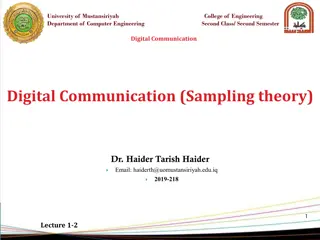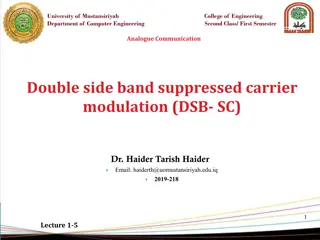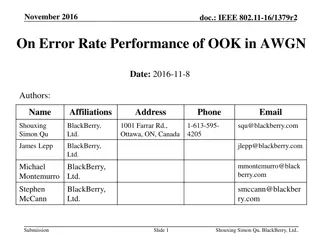Regulation of Energy Homeostasis by AMPK System and Its Modulation Factors
The AMPK system plays a crucial role in regulating energy homeostasis by sensing the cellular AMP:ATP ratio and responding to metabolic stresses that affect ATP production or consumption. AMPK is activated by factors such as hypoxia, glucose deprivation, and metabolic inhibitors, as well as by compounds like cytokines, drugs for type 2 diabetes, and natural plant products. This system, conserved across mammalian, yeast, and plant kingdoms, helps maintain cellular energy balance by adjusting catabolism and ATP consumption rates. Understanding AMPK and its modulation is important for managing energy metabolism and related health conditions.
Download Presentation

Please find below an Image/Link to download the presentation.
The content on the website is provided AS IS for your information and personal use only. It may not be sold, licensed, or shared on other websites without obtaining consent from the author. Download presentation by click this link. If you encounter any issues during the download, it is possible that the publisher has removed the file from their server.
E N D
Presentation Transcript
Regulation of energy homeostasis by the AMPK system Mammalian AMPK is sensitive to the cellular AMP: ATP ratio and is activated by metabolic stresses that inhibit ATP production (for example, hypoxia, glucose deprivation, addition of metabolic inhibitors) or those that stimulate ATP consumption (for example, activation of motor proteins, ion pumps or channels, or biosynthetic pathways). 1
AMPK-activated/SNF1 protein kinases: conserved guardians of cellular energy Living cells are capable to exploit the environment, constantly taking in energy to maintain a high ratio of ATP to ADP, analogous to a fully charged electrical cell or battery. Extending this analogy, catabolism (and photosynthesis in photosynthetic organisms) charges up the battery by converting ADP and phosphate to ATP, whereas almost all other cellular processes require energy and tend to flatten the battery by hydrolysing ATP to ADP and phosphate (or, in a few cases, to AMP and pyrophosphate). Living cells have evolved mechanisms that maintain the rates of catabolism in balance with rates of ATP consumption. AMP-activated protein kinase (AMPK), with its relatives in other eukaryotic kingdoms including the SNF1 complexes in yeasts and the SNF1-related kinases in plants (hereafter also referred to as SNF1 complexes), have been major players in maintaining this balance. 2
AMPK was originally defined as a mammalian protein kinase that was allosterically activated by AMP and was able to phosphorylate and inactivate enzymes of lipid synthesis. In Saccharomyces cerevisiae, the SNF1 (sucrose non- fermenting1) gene was discovered by a screen for mutations that caused failure to grow on sucrose, or on non-fermentable carbon sources such as glycerol and ethanol. Although SNF1 was shown to encode a protein kinase in 1986, it was not realized that it was the orthologue of AMPK until the catalytic subunit of the latter was sequenced in 1994. 3
It is also modulated by cytokines that regulate wholebody energy balance, including leptin, adiponectin, ghrelin, cannabinoids, interleukin6 and by drugs used to treat type 2 diabetes (including metformin and thiazolidinediones), and by natural plant products such as berberine, resveratrol (present in grapes and red wine) and ( )epigallocatechin3gallate (present in green tea), which are reported to have health giving properties that include the prevention of obesity and insulin resistance, and extension of lifespan. (ACC1 a subunit of acetyl-CoA carboxylase (ACC), a multifunctional enzyme system. Catalyzes the carboxylation of acetyl-CoA to malonyl-CoA, the rate-limiting step in fatty acid synthesis). 4
Once activated by metabolic stresses, cytokines or drugs, AMPK switches on catabolic pathways that generate ATP such as the uptake and metabolism of glucose and fatty acids, while switching off ATP- consuming, anabolic pathways such as the synthesis of fatty acids, cholesterol, glycogen and proteins. It achieves this by rapid phosphorylation of metabolic enzymes and by phosphorylation of transcription factors and coactivators that regulate gene expression. 5
Mammalian AMPK Citochine TAK1 Ormoni e citochine (Adiponectina, Leptina) CaMKK AMP LKB1(soppressore tumorale) Metformina ATP Ipossia Stress ossidativo 1, 2, 3 2-deossiglucosio AICAR Thr172P 1, 2 1, 2 K-activation loop Sensore omeostasi energetica Regolatore trascrizionale Controllo del ciclo cellulare ENERGY CHECKPOINT ! Glicolisi ON Blocco in G1 del ciclo cellulare ATP -OX acidi grassi ON Inibizione espressione FAS Inibizione sintesi proteica 6
Regulation and structure of AMPK All AMPK/SNF1 kinases appear to exist as heterotrimeric complexes comprising catalytic subunits and regulatory and subunits. The mammalian kinases are activated by AMP in two ways. First, the kinase activity that resides in the subunit is stimulated by the binding of AMP to the subunit. Second, AMP binding to the subunit also promotes phosphorylation of a Thr residue within the kinase domain (Thr172 in the subunits), the phosphorylation of which is essential for activity. The combination of the two effects causes >1000 fold increase in kinase activity. Therefore, the kinase acts as an energy sensor. AMP:ATP ratio is a sensitive indicator of cellular energy status Sak1, Elm1 and Tos3 were identified as kinases that function upstream of the SNF1 complex by various whole genome screening strategies. There is sufficient redundancy in the function of these three kinases such that all three must be knocked out to generate the same phenotype as a snf1 mutant. Although there are no clear orthologues of SAK1, TOS3 or ELM1 in the human genome, the protein kinases with kinase domains closest in sequence are LKB1 and the two calmodulin-dependent protein kinases, CaMKK and CaMKK . Subsequent studies revealed that both LKB1 and CaMKK act upstream of AMPK in mammalian cells. 7
Structure and regulation In mammals, the a subunit occurs as 2 isoforms ( 1/ 2), the subunit 2 ( 1/ 2) and the subunit 3 ( 1- 3), that give rise to 12 heterotrimeric combinations. The subunit has a kinase domain at the N-terminus that is only active after phosphorylation in the activation loop at Thr-172. The major upstream kinase phosphorylatinghr-172 was shown to be liver kinase B1 (LKB1), which was previously identified as a tumor suppressor. Loss- of-function mutations in LKB1 cause an inherited susceptibility to cancer (Peutz-Jeghers syndrome), whereas somatic mutations are frequent in some cancers, especially lung and cervical cancers. Although LKB1 also acts upstream of a small family of AMPK-related kinases, AMPK is its only target known to inhibit cell growth and proliferation, and thus, its tumor-suppressor effects may be mediated by AMPK. The subunit contains a glycogen-binding domain that causes the complex to bind to glycogen particles. It monitors the status of glycogen stores and ensures that they are rapidly replenished once depleted. Thus, AMPK may sense immediate energy availability and medium-term reserves in the form of glycogen. The subunit contains 2 sites that bind the regulatory nucleotides AMP and ATP in an antagonistic manner. 8
Mammalian AMPK and its role in balance energy Animals derive energy from oxidation of reduced carbon compounds in food and use this to synthesize ATP from ADP. The consequent high ATP:ADP ratio drives most of the energy-requiring reactions that occur in the cell. It is essential that ATP-producing and -consuming processes are maintained in a balance, and this is achieved by the action of regulatory systems that include AMP-activated protein kinase (AMPK). In recent years, AMPK has attracted much attention because of its relevance to the epidemics of obesity and type 2 diabetes. AMPK appears to mediate the therapeutic benefits of the anti-diabetic drug metformin and of xenobiotics or nutraceuticals such as resveratrol. AMPK is a target for the adipokines leptin and adiponectin and accounts for many of the health benefits of regular exercise. 9
Evolution Mammalian AMPK exists as heterotrimeric complexes that comprised a catalytic a subunit and regulatory and subunits, and genes that encode these subunits are readily recognized in other eukaryotic kingdoms (i.e. plants, fungi and protists). In the yeast Saccharomyces cerevisiae,Snf1, the AMPK ortholog, is required for the response to glucose starvation. When grown in high glucose concentrations, yeast use fermentation to generate ATP and produce ethanol. When the glucose concentration runs low yeast switch to the use of oxidative metabolism or other fermentable sugars, such as sucrose, and Snf1 switches on genes required for these transitions. In the nematode worm Caenorhabditiselegans, AMPK is required for life- span extension in response to a caloric restriction or other stresses in early life. In the green plant Physcomitrella patens, AMPK orthologs are not required for growth in continuous light but are essential if plants are grown on a more physiologic light and dark cycle. Because darkness is the equivalent of starvation for a plant, these observations support the idea that the ancestral role of AMPK was in the response to starvation for a carbon source. 10
The binding of AMP, which is a signal of low cellular energy status, promote the phosphorylation of the subunit at Thr-172, which causes its activation Thecurrent model is that LKB1 has a high basal activity and continuously phosphorylates Thr-172, but in the absence of AMP, it is immediately dephosphorylated. However, the binding of AMP causes a conformational change that inhibits the dephosphorylation of AMPK. Soon after the discovery that LKB1 acted upstream of AMPK, another upstream kinase was found, the calmodulin-dependent kinase kinase (CaMKK ). This pathway activates AMPK in response to a rise in cytosol Ca2+. Because increases in cytosolic Ca2+ often trigger ATP-requiring processes such as contraction or secretion, this mechanism anticipates a demand for ATP before it actually occurred. 11
In general, AMPK activation stimulates ATP-producing, catabolic pathways and inhibits ATP- consuming anabolic pathways, both by rapid effects via direct phosphorylation of metabolic enzymes, and by longer term effects via regulation of transcription. 12
AMPK ha come bersaglio enzimi chiave della produzione e del consumo di energia 6-phosphofructo-2-kinase/fructose-2,6-bisphosphatase fosforitalata da AMPK. La conseguenza l aumentata sintesi di fruttosio-2,6- bisfosfato che, essendo un attivatore allosterico dell enzima glicolitico 6- fosfofrutto-1-chinasi (PFK2), che determina la stimolazione della glicolisi (miociti). (PFKFB) Glicogeno sintasi fosfoforilata da AMPK ed inibita (muscolo). Acetil-CoA carbossilasi (sintesi degli acidi grassi) fosforilata da AMPK ed inibita 3-idrossi-3metilglutaril-CoA reduttasi, che catalizza la reazione regolatrice chiave nella sintesi del colesterolo, viene fosforilata ed inibita da AMPK (fegato). AMPK potenzia anche la produzione di energia favorendo la biogenesi mitocondriale 13
AMPK controlla lomeostasi energetica in tutto il corpo (1) Muscolo scheletrico AMPK attivata da ormoni come l adiponectina e la peptina, ormoni prodotti dagli adipociti che regolano i comportamenti alimentari e l omeostasi energetica AMPK attivata anche dall attivit fisica Effetti: AMPK attiva assorbimento del glucosio, l ossidazione degli acidi grassi e la biogenesi mitocondriale (fosforilando sia enzimi metabolici trascrizionali che controllano l espressione genica di geni coinvolti nella produzione e del consumo di energia) Fegato AMPK attiva determina un minor consumo di ATP tramite inibizione della sintesi degli acidi grassi, della sintesi del colesterolo e della gluconeogenesi sia fattori 14
AMPK controlla lomeostasi energetica in tutto il corpo (2) Fegato Metformina, un farmaco largamente usato per il trattamento del diabete di tipo 2, determina l attivazione di AMPK . Questo determina un abbassamento dei livelli di glucosio nel sangue mediante l inibizione della gluconeogenesi del fegato Cellule pancreatiche AMPK blocca la secrezione di insulina che noto essere un ormone che favorisce l accumulo di energia mediante la sintesi del glicogeno e degli acidi grassi 15
Regulation of transcription In mammals, AMPK activation downregulates expression of biosynthetic genes, such gluconeogenesis and lipogenesis in the liver, and upregulates genes involved in catabolism, such as GLUT4 and mitochondrial genes in muscle. These effects are achieved by phosphorylation of numerous targets, including transcription factors and coactivators. as those involved in 16
Model for regulation by AMPK of glucose uptake in muscle One key effect of AMPK is its capability to stimulate glucose uptake in muscle by increasing the translocation of the glucose transporter GLUT4 from intracellular storage vescicles to the plasma membrane. Fusion of these vescicles with the plasma membrane requires members of the Rab family of G proteins to be in their GTP-bound state. Activation of AKT/protein kinase B (PKB) by the insulin signalling pathway, or activation of the AMP-activated protein kinase (AMPK) pathway by metabolic stress, causes phosphorylation of AS160 (160 kDa). AS160 contains a GTPase activating protein (GAP) domain for small G-proteins of the Rab family A current model is that AS160 phosphorylation triggers dissociation of AS160 from the GLUT4 storage vesicle, preventing AS160 from converting the Rab protein to its inactive GDP form. The activated Rab GTP complex then promotes docking and/or fusion of the GLUT4 storage vesicle with the plasma membrane. 17
Regulation of catabolic pathways AMPK also promotes glucose intake into cells expressing only GLUT1 (which includes most cells other than those in muscle, liver and adipose tissue) via a mechanism that involves activation of GLUT1 that is already located at the plasma membrane AMPK promotes fatty acid uptake into cardiac myocytes via translocation of vescicles containing the fatty acid transporter CD36 to the plasma membrane After glucose and fatty acids have entered the cell, AMPK can promote the catabolism of glucose via glycolysis and of fatty acids by enhancing their uptake into mitochondria and their consequent breakdown by the -oxidation pathway Uptake of fatty acids into mithocondria, which is the rate limiting step in -oxidation, is promoted by AMPK via phosphorylation of ACC-2 18
Regulation of fatty acid synthesis and oxidation by the AMP-activated protein kinase Acetyl-CoA carboxylase (ACC) exists in mammals as two isoforms: ACC-1 and ACC-2 (also known as ACC- and ACC- ) ACC-1 is ubiquitously expressed in many tissues, but higher levels occur in lipogenic tissues including liver and adipose tissue ACC1 is a cytosolic enzyme ACC1 gene expression and activity are markedly induced either by high carboydrate feeding or hyperinsulinemia in animals, resulting in increased fatty acids synthesis In contrast to ACC1, ACC2 is anchored to the mitochondrial surface via a unique N-terminal domain consisting of 20 hydrofobic amino acids (mito- sequence) and and co-localizes acyltransferase 1 (CPT1) (outer mithocondial membrane) ACC-2 is the only form that appears to be expressed in skeletal and cardiac muscle, and both forms are expressed in liver with carnitine:palmitoyl-CoA 19
Regulation of fatty acid synthesis and oxidation by the AMP-activated protein kinase ACC2 produces malonyl-CoA on the mitochondrial surface; insulin and citrate can modulate this process depending on nutritional status Malonyl-CoA produced by ACC-2 is exclusively involved in regulation of fatty acid oxidation, whereas that produced by ACC-1 is utilized in fatty acid synthesis. AMPK phosphorylates and inactivates both isoforms Activation of AMPK by cellular stress or exercise switches on fatty acid oxidation (via phosphorylation of ACC-2) while switching off fatty acid synthesis (via phosphorylation of ACC-1) Skeletal and cardiac muscle do not express fatty acid synthase and do not therefore carry out de novo fatty acid synthesis to any significant extent 20
Phosphorylation sites of ACC-1 and ACC-2 Phosphorylation of ACC-1 by AMPK occurs most rapidly at Ser79, and this correlates with its inactivation All three AMPK sites (Ser79, Ser1200 Ser1215) were found to be phosphorylated in ACC-1 purified from rat liver Because of the N-terminal extension in ACC-2, the serine residue equivalent to Ser79 in ACC-1 is Ser219 in ACC-2 21
Pathways mediating lipid synthesis and oxidation The malonyl- CoA produced by ACC-2 has a specific role in regulation of fatty acid oxidation. Malonyl-CoA produced by ACC2 is the potent endogenous inhibitor of CPT1(carnitine:palmitoyl-CoA acyltransferase 1) Thus ACC2 prevents mitochondrial fatty acid -oxidation In response to activation of AMPK by cellular stress or exercise ACC2 activity and it product, malonyl-CoA are decreased These conditions allow for greater mitochondrial fatty acid -oxidation 22
Proposed mechanism of action of AICAR, an AMPK activator The phosphorylation state of ACC-1 varies in vivo with a diurnal rhythm, with the enzyme being highly phosphorylated and inactive during the dark period when the rats are not eating and rates of fatty acid synthesis are low, while it becomes partially dephosphorylated and more active in the light period when the rats are eating and rates of fatty acid synthesis are high. 5-aminoimidazole-4-carboxamide (AICAR) riboside is taken up into cells on nucleoside transporters and phosphorylated to the corresponding monophosphate, usually termed ZMP (5-aminoimidazole-4-carboxamide ribonucleoside monophosphate), in the cytoplasm. AMPK is activated either directly by ZMP or indirectly by formation of AMP (the latter appears not to be the case in hepatocytes, where there is no change in the contents of ATP, ADP or AMP, indicating that metabolism of ZMP to AMP is slow). AICAR causes a dramatic inhibition of fatty acid and cholesterol synthesis 23
AMPK-activation mediated by AICAR in muscle In hindlimb muscle of rats during treadmill exercise, ACC-2 becomes inactivated as AMPK becomes activated These events are connected, because perfusion of rat hindlimb muscle with AICAR causes activation of AMPK, inactivation of ACC-2, a decrease in muscle malonyl-CoA and increased fatty acid oxidation. A dramatic increase in phosphorylation of ACC-2 at the AMPK site also occurs in human muscle during exercise, as shown by probing Western blots of biopsies using a phosphospecific antibody. Taken together, these results suggest that AMPK plays a critical role in stimulating fatty acid oxidation via phosphorylation of ACC- 2, under conditions where ATP is in short supply. 24
Mammalian AMPK and cell cycle progression Cellule di mammifero in crescita in basso glucosio hanno una velocit di crescita minore rispetto a concentrazione di glucosio non limitanti. In cellule di mammifero la disponibilit di glucosio regola la via mediata dalla chinasi AMPK ( sensore della concentrazione di AMP/ATP ). In cellule in crescita su basso glucosio AMPK si attiva in seguito alla fosforilazione in T172. Per attivare AMPK si possono trattare le cellule con un composto specifico analogo dell AMP, l AICAR (5- aminoimidazolo-4-carbossiammideribosio). Quando le cellule vengono trattate con AICAR si ha un blocco specifico in fase G0/G1. All aumentare delle dosi di AICAR aumenta il numero di cellule bloccate in fase G1. Jones et al, 2005 25
Mammalian AMPK L arresto in fase G1 in basso glucosio richiede l attivazione di AMPK e la presenza di p53. Il trattamento con dosi crescenti di AICAR provoca un aumento della fosforilazione di p53. Questa fosforilazione richiesta per la sua attivazione (human 293T cells) Cellule in crescita rispondono a diversi livelli di glucosio presenti nel mezzo di coltura modulando l entrata in fase S. Cellule poste poste in carenza di glucosio regolano il superamento della transizione G1/S mediante l attivazione della proteina chinasi AMPK, l attivazione di p53, l up-regolazione di p21. Jones et al, 2005 26
AMPK e la regolazione della crescita AMPK coinvolta nella regolazione della crescita cellulare mediante la fosforilazione di una proteina chiamata TSC2. La fosforilazione di TSC2 porta all inibizione di mTORC1, un complesso contenente mTOR, un membro della famiglia delle proteine-chinasi correlate alla fosfatidilinositolo-3-chinasi. L attivazione di mTOR favorisce la sintesi delle proteine , la crescita e la proliferazione cellulare. Come conseguenza, l inibizione di mTORC1 dovuta ad AMPK ha come effetto l inibizione della sintesi proteica e della crescita e quindi la conservazione dell energia. 27


























